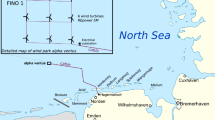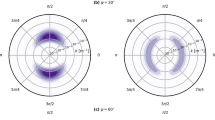Abstract
Laboratory experiments and field observations show that the equilibrium range of wind wave spectra presents a −4 power law when it is scaled properly. This feature has been attributed to energy balance in spectral space by many researchers. In this paper we point out that white noise on an oscillation system can also lead to a similar inverse power law in the corresponding displacement spectrum, implying that the −4 power law for the equilibrium range of wind wave spectra may probably only reflect the randomicity of the wind waves rather than any other dynamical processes in physical space. This explanation may shed light on the mechanism of other physical processes with spectra also showing an inverse power law, such as isotropic turbulence, internal waves, etc.
Similar content being viewed by others
References
Alpers, W., 1985. Theory of radar imaging of internal waves. Nature, 314: 245–247.
Banner, M. L., 1990. Equilibrium spectra of wind waves. J. Phys. Oceanogr., 20: 966–984.
Battjes, J. A., T. J. Zitman, and L. H. Holthuijsen, 1987. A reanalysis of the spectra observed in JONSWAP. J. Phys. Oceanogr., 17: 1288–1295.
Belcher, S. E., and J. C. Vassilicons, 1997. Breaking waves and the equilibrium range of wind-wave spectra. J. Fluid Mech., 342: 377–401.
Forristall, G. Z., 1981. Measurements of a saturated range in ocean wave spectra. J. Geophys. Res., 86: 8075–8084.
Gasparovic, R. F., J. R. Apel, D. R. Thompson, and J. S. Tovhko, 1986. A comparison of SIR-B synthetic aperture radar data with ocean internal wave measurements, Science, 232: 1529–1531.
Hasselmann, K., T. P. Barnett, E. Bouws, H. Carlson, D. E. Cartwright, et al., 1973. Measurements of wind wave growth and swell decay during the Joint North Sea Wave Project (JONSWAP). Ergänzungsheft Zeit. Deut. Hydr. Zeit., 12: 1–95.
Jin, M. B., and Y. L. Yuan, 1997. Formulation and solution of the mathematical and physical inverse problem of detecting submarine topography by using SAR image. Oceanologia et Limnoligia Sinica, 28 (Suppl.): 27–31 (in Chinese).
Kahma, K. K., 1981. A study of the growth of the wave spectrum with fetch. J. Phys. Oceanogr., 11: 1503–1515.
Kawai, S., K. Okuda, and Y. Toba, 1977. Field data support of three-seconds power law and gu*σ−4 spectral form for growing wind waves. J. Oceanogr. Soc. Japan, 33: 137–150.
Kitaigorodskii, S. A., 1983. On the theory of the equilibrium range in the spectrum of wind-generated gravity waves. J. Phys. Oceanogr., 13: 816–827.
Kudryavtsev, V. N., V. K. Makin, and B. Chapron, 1999. Coupled sea surface-atmosphere model 2. Spectrum of short wind waves. J. Geophys. Res., 104: 7625–7639.
Liu, A. K., J. R. Apel, and J. R. Holbrook, 1985. Nonlinear internal wave evolution in the Sulu Sea. J. Phys. Oceanogr., 15: 1613–1624.
Liu, A. K., Y. S. Chang, M. K. Hsu, and N. K. Liang, 1998. Evolution of nonlinear internal waves in China Seas, J. Geophys. Res., 103(C4): 7997–8008.
Makin, V. K., V. N. Kudryavtsev, and C. Mastenbroek, 1995. Drag of the sea surface. Boundary-Layer Met., 73: 159–182.
Makin, V. K., and V. N. Kudryavtsev, 1999. Coupled sea surface-atmosphere model 1. Wind over waves coupling. J. Geophys. Res., 104: 7613–7623.
Phillips, O. M., 1958. The equilibrium range in the spectrum of wind-generated waves. J. Fluid Mech., 4: 426–434.
Phillips, O. M., 1985. Spectral and statistical properties of the equilibrium range in wind-generated gravity waves. J. Fluid Mech., 156: 505–531.
Pierson, W. J. Jr., and L. Moscowitz, 1964. A proposed spectral form for fully developed wind seas based on the similarity theory of S. A. Kitaigorodskii. J. Geophys. Res., 69: 5181–5190.
Selvam, A. M., D. Sen, and S. M. S. Mody, 2000. Critical fluctuation in daily incidence of acute myocardial infarction. Chaos, Solitons and Fractals, 11: 1175–1182.
Sun, F., and P. X. Ding, 1994. A statistical distribution of surface elevation for nonlinear random sea waves and its physical explanation. Science in China (Ser. B), 37(11): 1401–1408.
Toba, Y., 1973. Local balance in the air-sea boundary processes. 1. On the spectrum of wind waves. J. Oceanogr. Soc. Japan, 29: 209–220.
Valenzuela, G. R., 1978. Theories for the interaction of electro-magnetic and oceanic waves-a review. Boundary Layer Meteorol., 13: 61–85.
Wen, S. C., and Z. W. Yu, 1984. Theory of Ocean wave and Its Computational Method. Beijing, Science Press, 662pp (in Chinese).
Yuan, Y. L., and F. Hua, 2005. Representation of microscale ocean wavenumber spectrum correct to the second order. Science in China (Ser. D), 48(4): 549–554.
Author information
Authors and Affiliations
Corresponding author
Rights and permissions
About this article
Cite this article
Dai, D., Wang, W., Qiao, F. et al. The equilibrium range of wind wave spectra: an explanation based on white noise. J Ocean Univ. China 6, 345–348 (2007). https://doi.org/10.1007/s11802-007-0345-6
Received:
Accepted:
Issue Date:
DOI: https://doi.org/10.1007/s11802-007-0345-6




